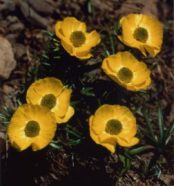Tracking the sun Improves plant pollen
Turning to face the sun helps snow buttercups make better pollen.
By Emily Sohn
A free flower is a happy flower. Or so it seems.
In a recent study, snow buttercup flowers that were free to move with the sun were more likely to produce baby blooms than did flowers that were tied down.
 |
|
Snow buttercups grow at high altitudes in the Rocky Mountains.
|
| C. Galen/Univ. of Missouri, Columbia |
Snow buttercups poke up through melting snow in the Rocky Mountains of Colorado. They are one of a handful of types of plants that track the motion of the sun.
Scientists from California and Missouri restrained the movements of some of the flowers by slipping slit drinking straws around their stems, putting them into plastic straitjackets. The researchers left other blooms to move freely. Later, the scientists took pollen from the flowers and used it to fertilize other flowers.
Pollen that formed in free flowers ended up being 32 percent more likely to make baby buttercups compared to pollen from restrained flowers, the scientists reported. In a similar test of the flowers that received the pollen, the pollen was 40 percent more likely to get active when it landed in sun-tracking flowers than it was in restrained flowers.
The researchers think that tracking the sun helps buttercups maintain ideal levels of temperature and humidity.
An alternative explanation: Maybe flowers appreciate a little freedom, too.







